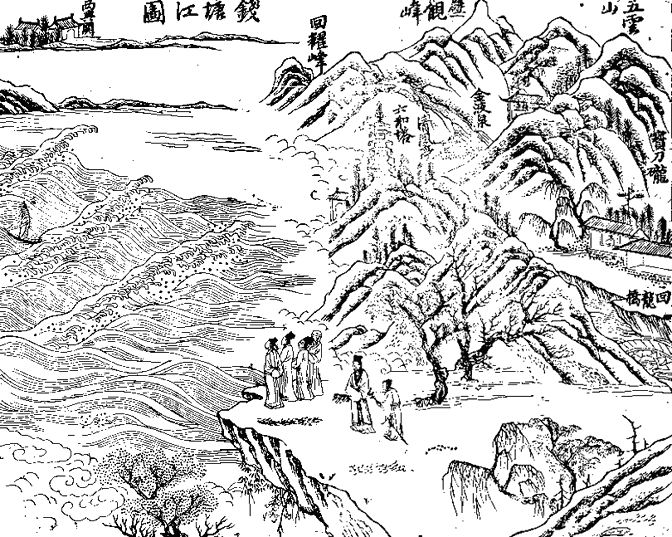30—
Chou Mi (1232–1298)

Many writers and poets since the T'ang have mentioned the tidal bore along the Ch'ien-t'ang River as an awesome phenomenon. Known to Westerners during the last century and a half as the "Hangchow Bore," it is a series of high waves that occurs near the first and middle of each month, with an average crest height of five to six feet. The two occurrences nearest the spring and autumn equinoxes, however, can reach a height of eighteen to twenty-five feet. These events used to be the cause for festivities; here, Chou Mi vividly describes the autumnal one in the eighth lunar month during the Southern Sung.
Chou Mi's family originated in Chi-nan in what is today Shantung, but they migrated to Wu-hsing in present-day Che-chiang after the fall of the Northern Sung. Chou Mi was able to enter official service at the end of the Southern Sung thanks to privileges accorded his father, a poet, art collector, and bibliophile who had served as magistrate of Fu-ch'un in modern Che-chiang. Chou Mi also became a magistrate in I-wu, modern Che-chiang, in 1276 but resigned when the Mongol armies arrived. During his lifetime, he was best known as a writer of tz'u and shih poetry, especially the former. Many of his pieces are "descriptions of objects" (yung-wu ) in the formalist style, which emphasized elevated diction and careful attention to metrics. He largely ceased writing these after the fall of the dynasty. Following the unification of the country under the Yüan in 1279 he remained in retirement as a Sung loyalist and moved to Hang-chou when his family business burned down in Wu-hsing. His later years were spent preserving Sung literature and culture. He also wrote several unofficial histories, including Recollections of Wu-lin (Wu-lin chiu-shih , ca. 1280), an

Fig. 38.
Observing the Tidal Bore . From Hai-nei ch'i-kuan (1610), Deutsche Staatsbibliothek, Berlin.
extensive and detailed record of life in the Southern Sung capital. It contains a variety of short descriptions such as this one, in addition to poems, lists of noteworthy things, and selections from other sources covering not only court life but also popular culture, scenic places, and the daily life of the common people.
Today, the height of the tidal bore has diminished because of dams, and it can no longer be seen from the city as in the past. One must travel forty miles away to Hai-ning on Hang-chou Bay for the best view; there, the sixty-mile wide bay narrows to two miles and the incoming tide confronts the outgoing flow of the Ch'ien-t'ang River.
From Recollections of Wu-lin: Observing the Tidal Bore  (ca. 1280)
(ca. 1280)

The tidal bore on the Che River[1] is one of the great sights of the world. It reaches its full force from the sixteenth to the eighteenth of the month. When it begins to arise far away at Ocean Gate,[2] it appears but a silver thread; but as it gradually approaches, it becomes a wall of jade, a snow-laden ridge, bordering the sky on its way. Its gigantic roar is like thunder as it convulses, shakes, dashes, and shoots forth, swallowing up the sky and inundating the sun, for its force is supremely vigorous. Yang Wan-li described this in a poem:
The ocean surges silver to form a wall;
The river spreads jade to gird the waist.[3]
As in every year, the governor of the capital appeared at the Che River Pavilion[4] to inspect the navy. Warships in the hundreds were arrayed along both banks. Suddenly, they all rushed to divide into "quintuple formation." Moreover, there was equitation, banner waving, spear juggling, and sword dancing while afloat, just as on land. In an instant, yellow smoke arose on all sides, and people could barely see each other. The explosions on the water were deafening and earthshaking; the sounds were like those of mountains collapsing. When the smoke dispersed and the waves calmed, there was not a trace of a hull: all the "enemy ships" had been burned by fire and had disappeared under the waves.
There were several hundred youths of Wu who were expert at swimming. They had loosened their hair and had tattoos on their bodies. In their hands they held colored banners some twenty feet in size and raced against each other with the utmost exertion, swimming against the current, floating and sinking in the leviathan waves a myriad jen high. Their leaping bodies executed a hundred different movements without getting the tail of the banners even slightly wet—this was how they showed off their skill. Prominent commoners and high officials competed to bestow silver prizes.
Up and down along the river banks for more than three miles, pearls, jade, gauze, and silk flooded the eyes; horses and carriages clogged the roads. Every kind of food and drink cost double the normal price, and yet, where viewing tents were rented out, not a bit of ground was left for even a mat. The palace viewed the scene, as customary, from Nature's Picture.[5] From this high terrace, the bird's-eye view made it all appear as if in the palm of one's hand. The people of the capital gazed up at the yellow canopies and feathery fans above in the empyrean, just as if it were the Flute Terrace or the Island of P'eng-lai.[6]